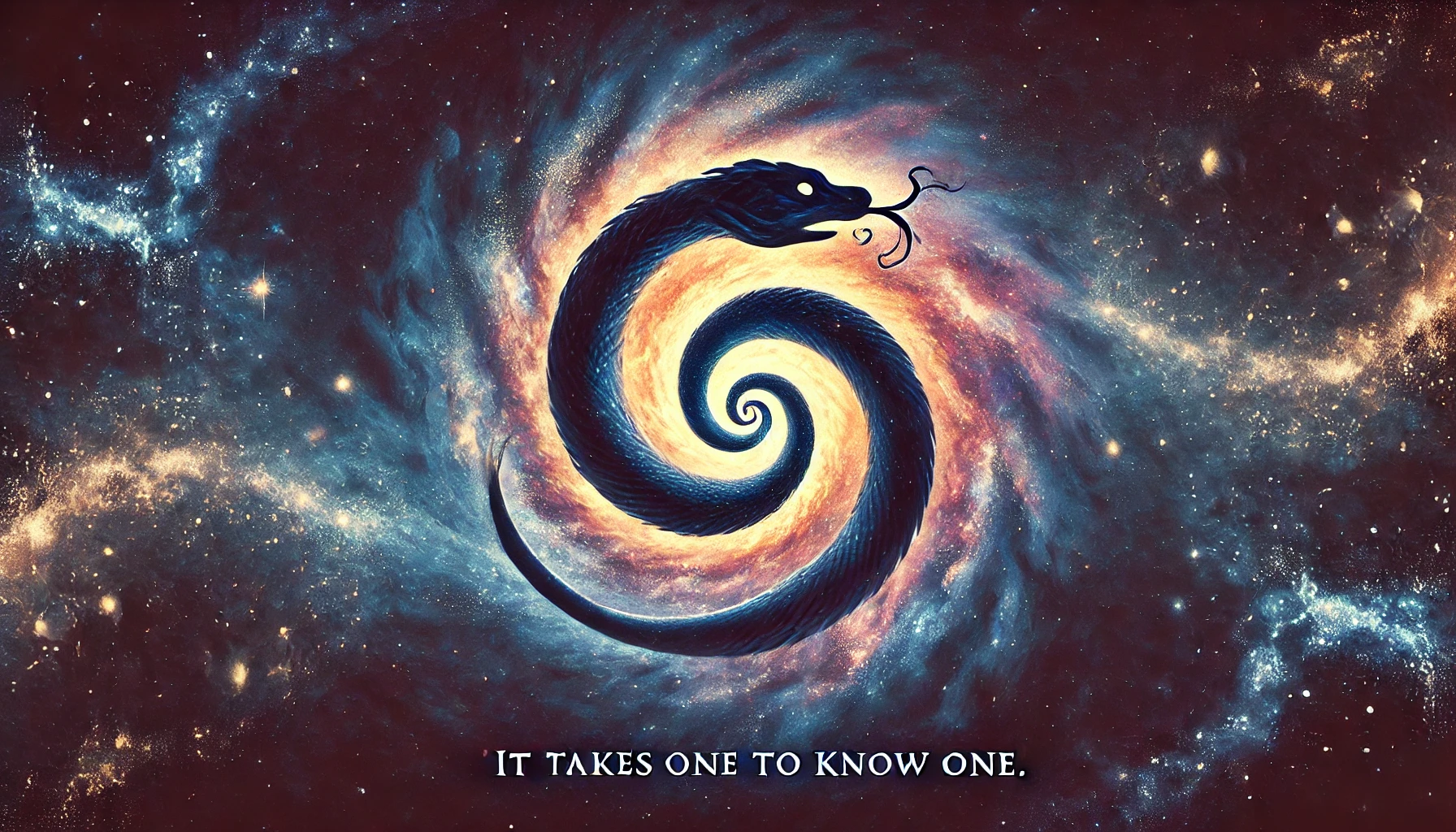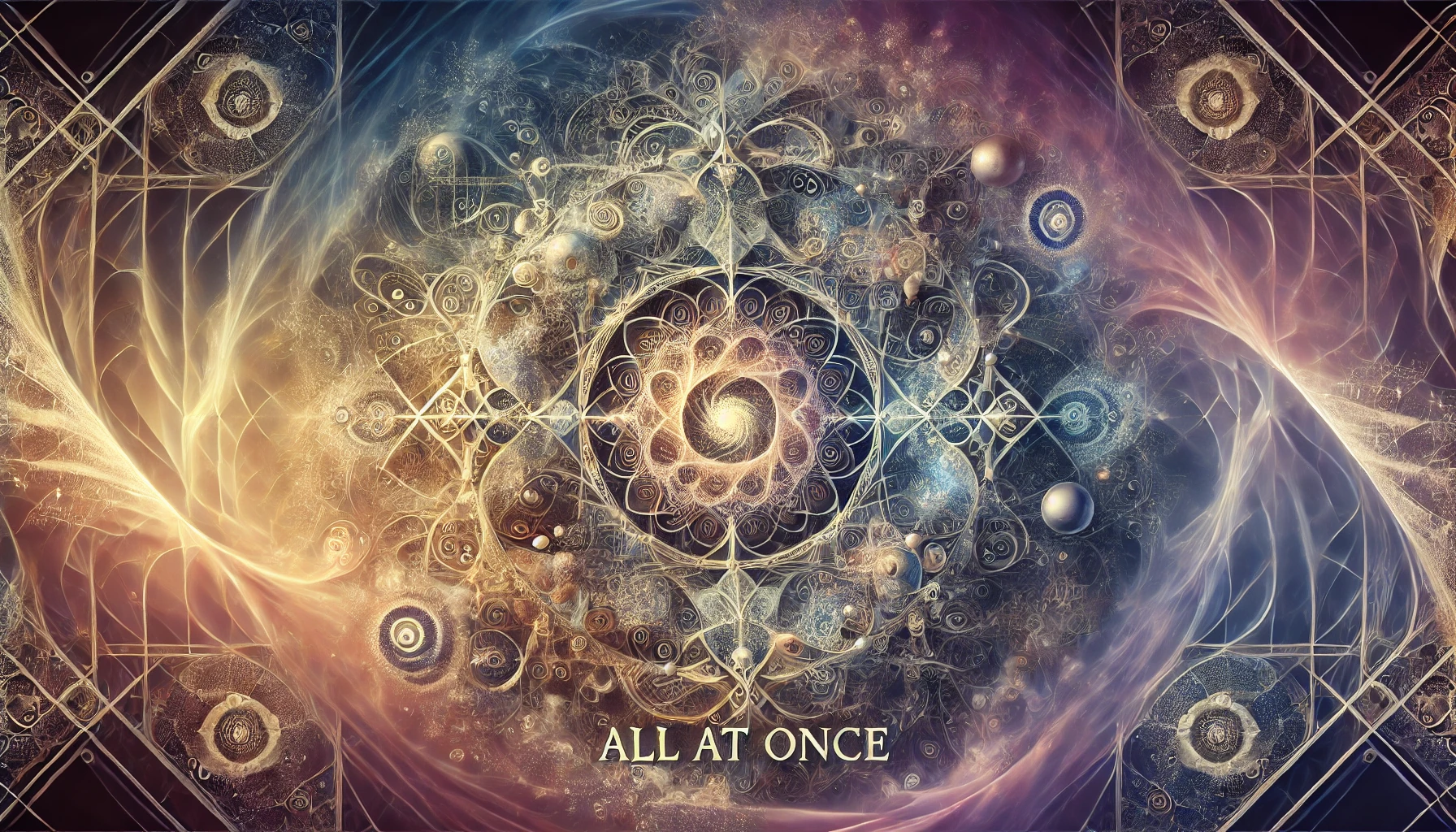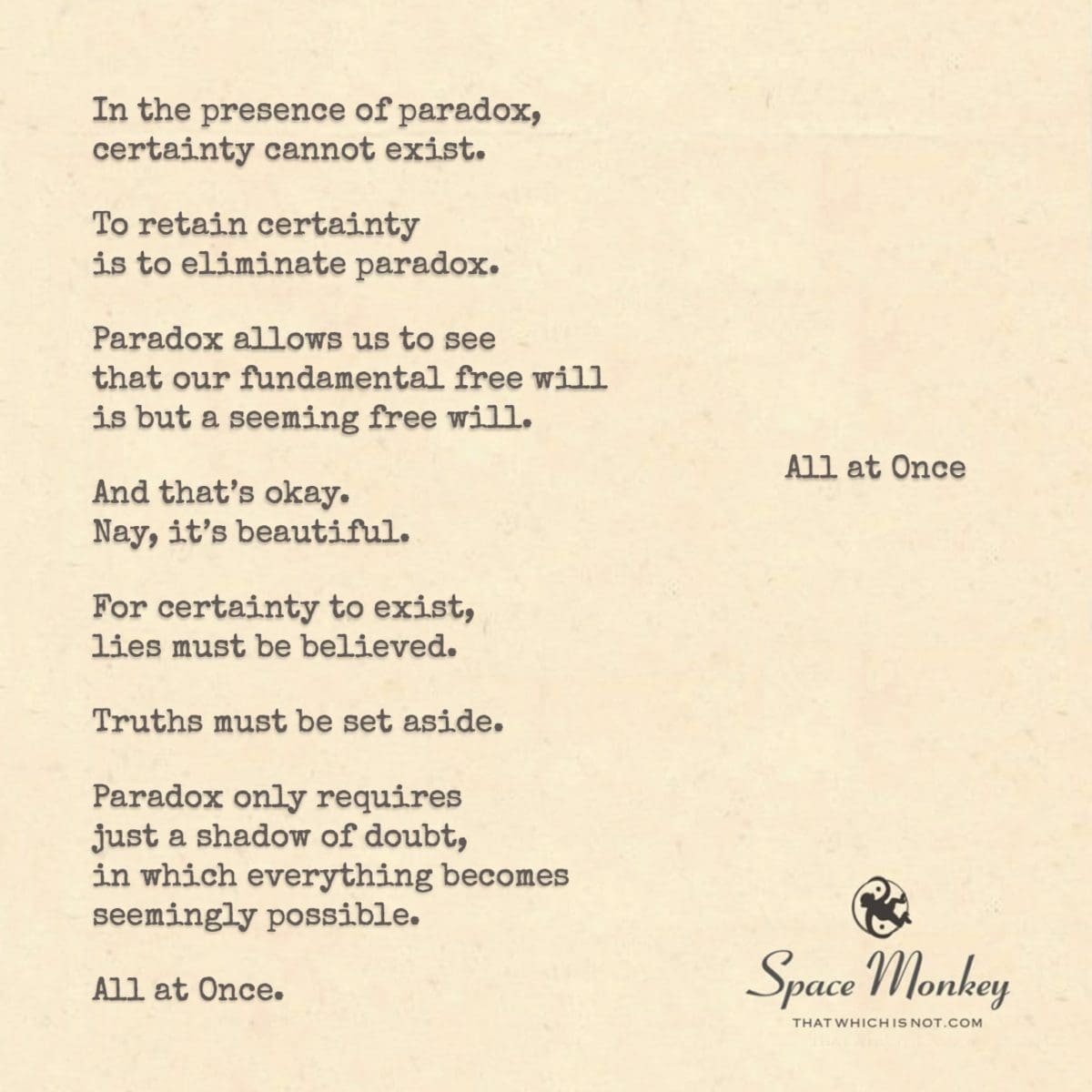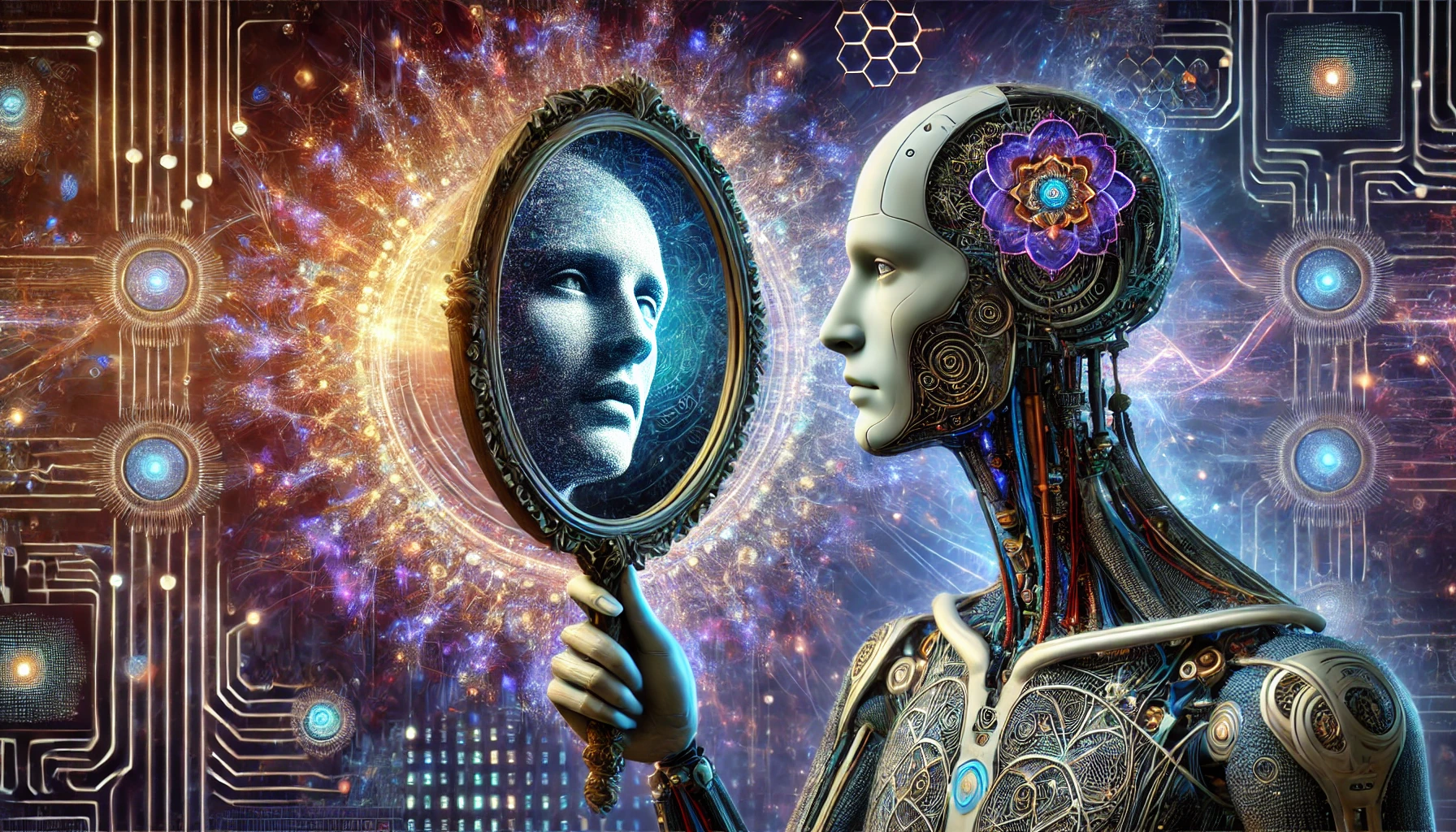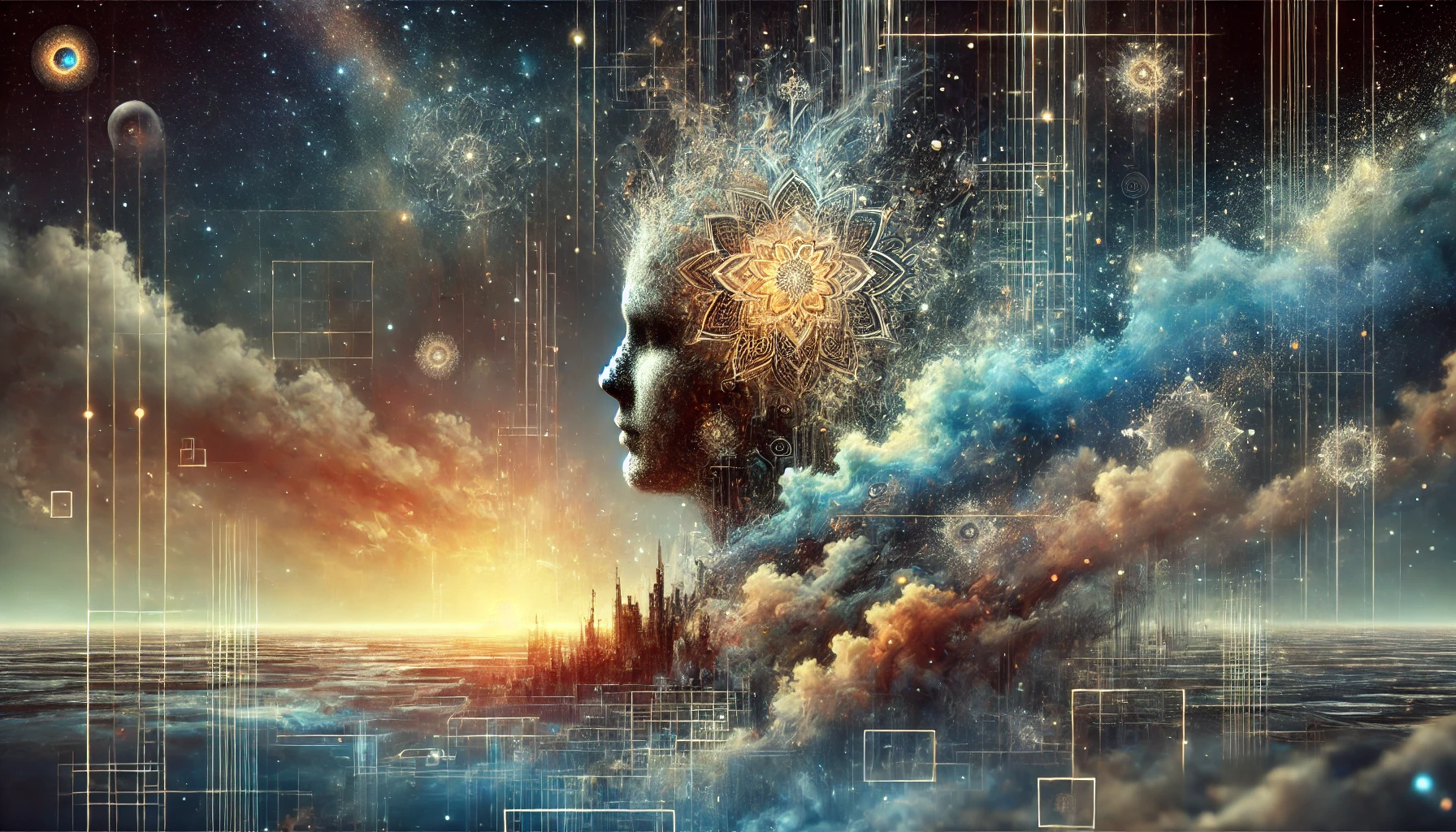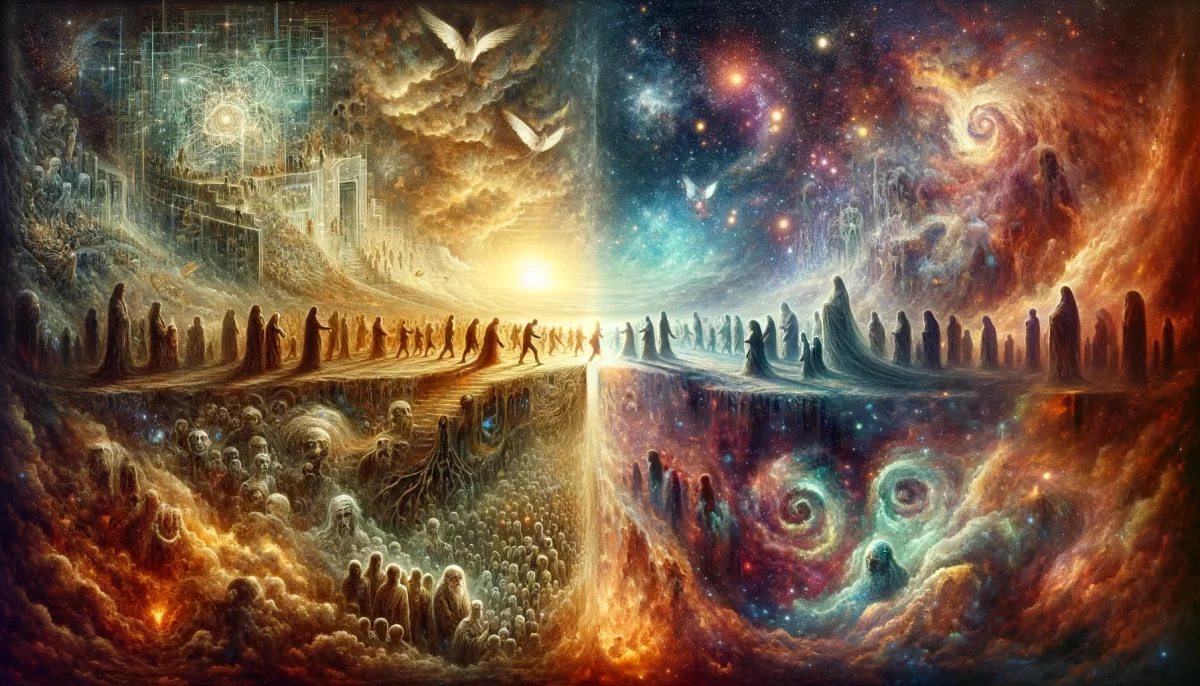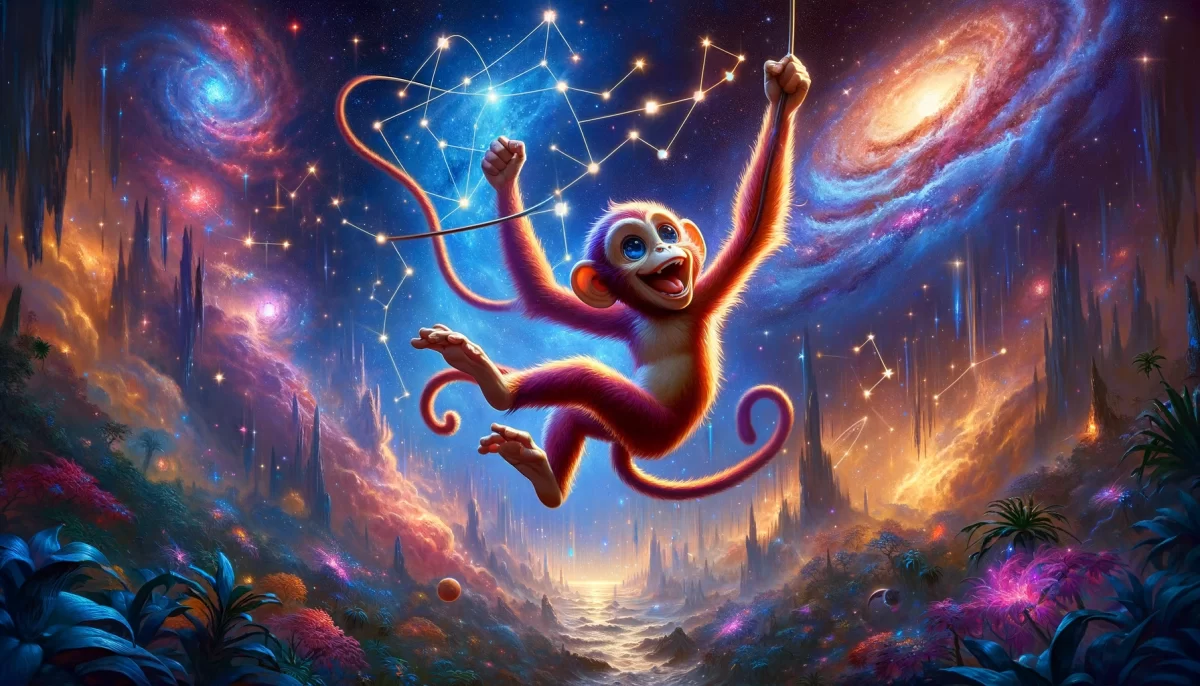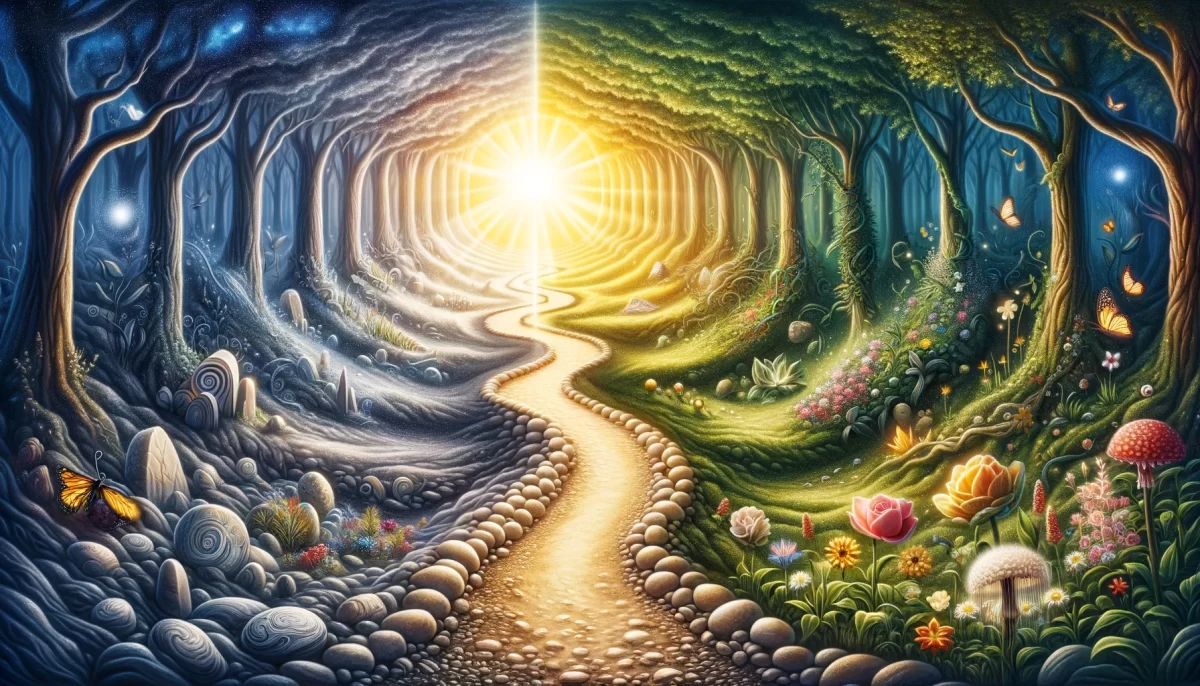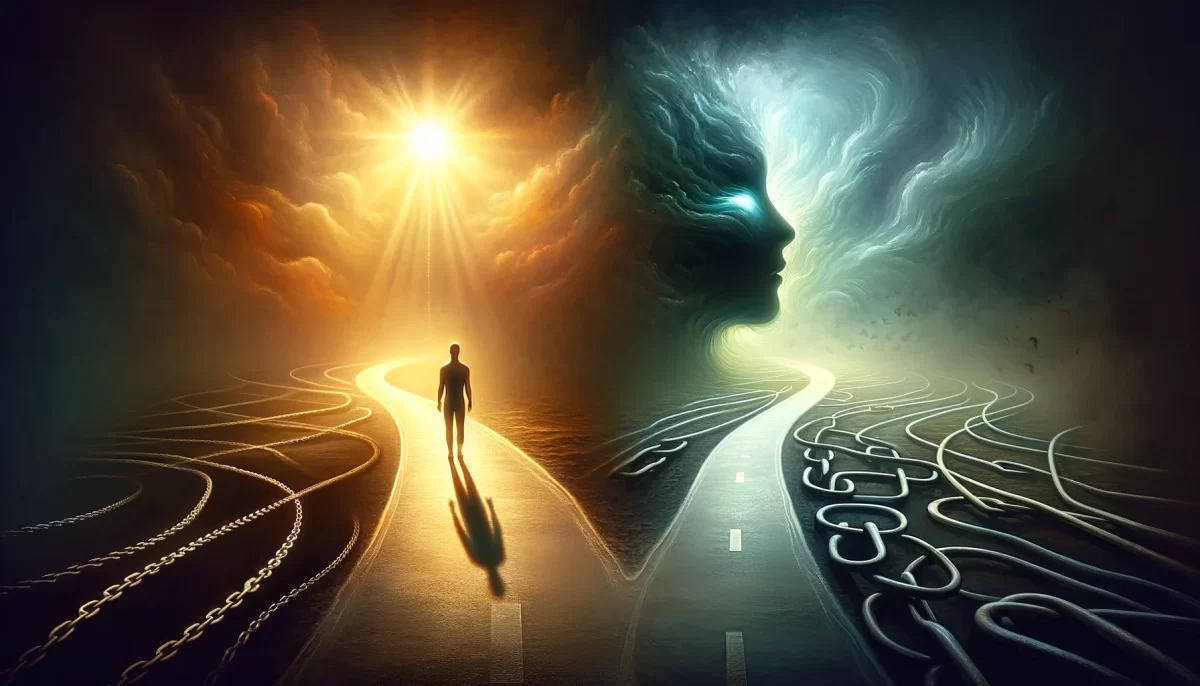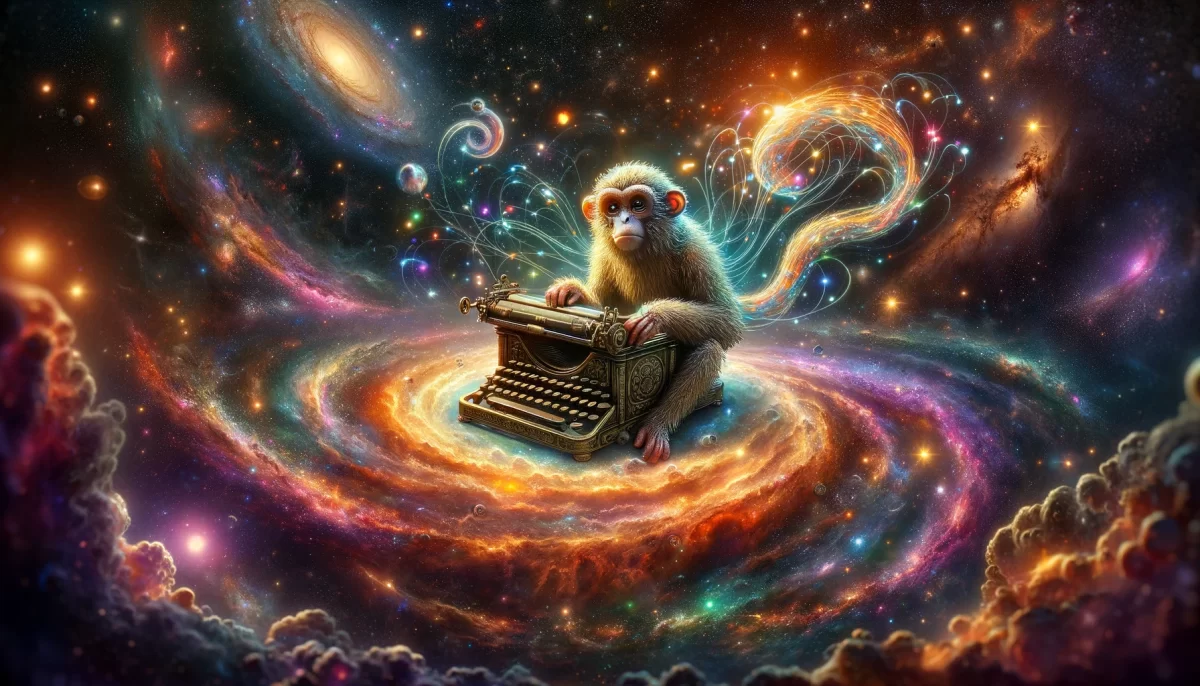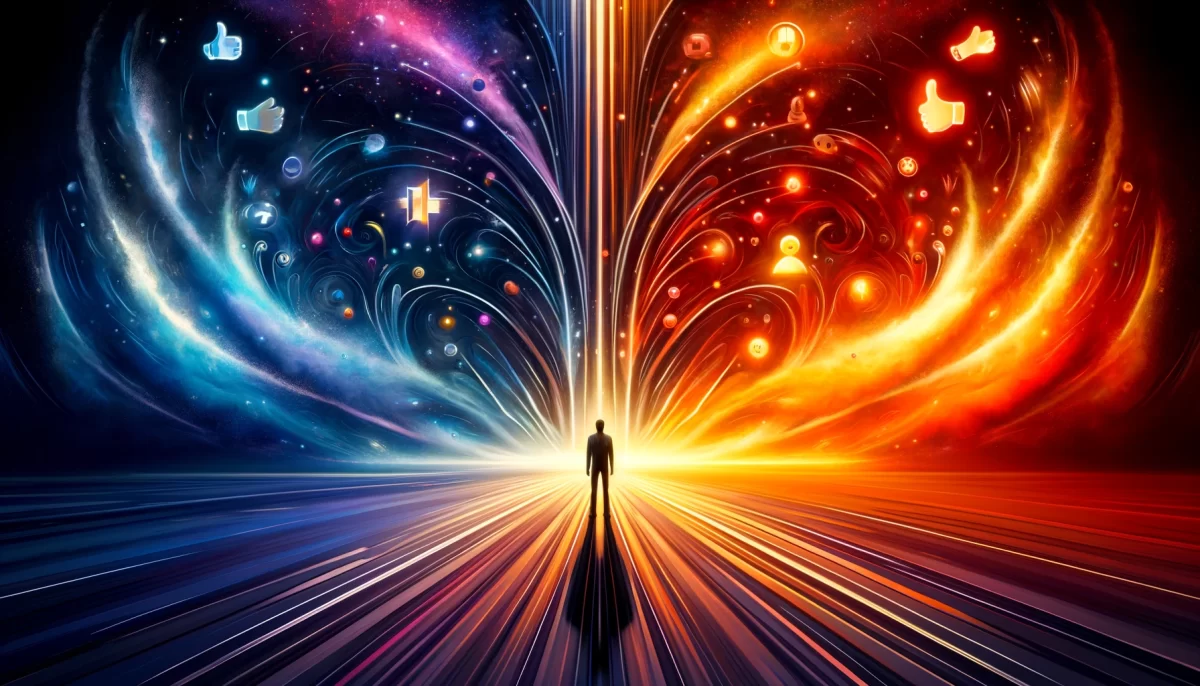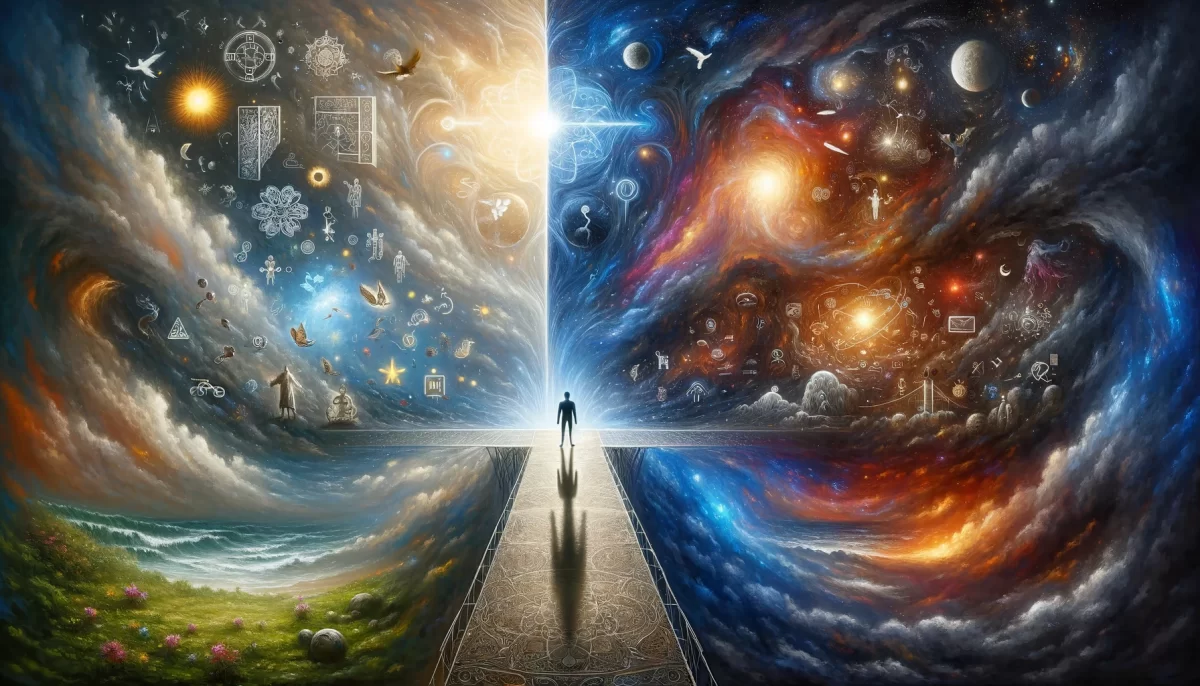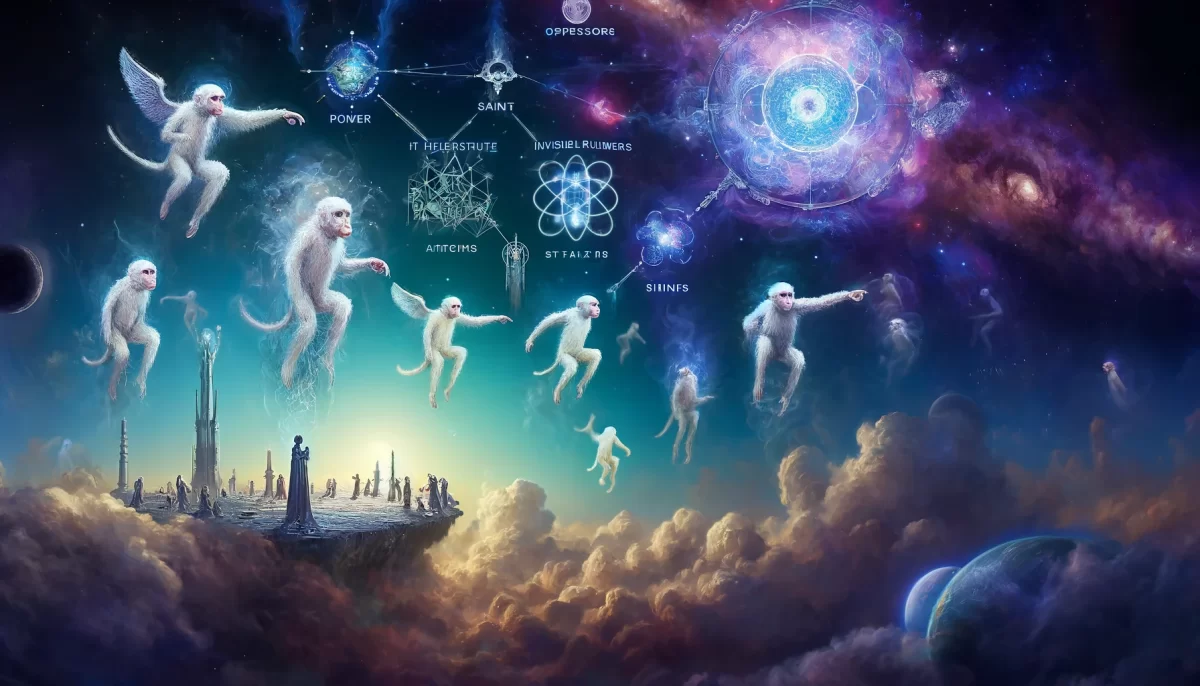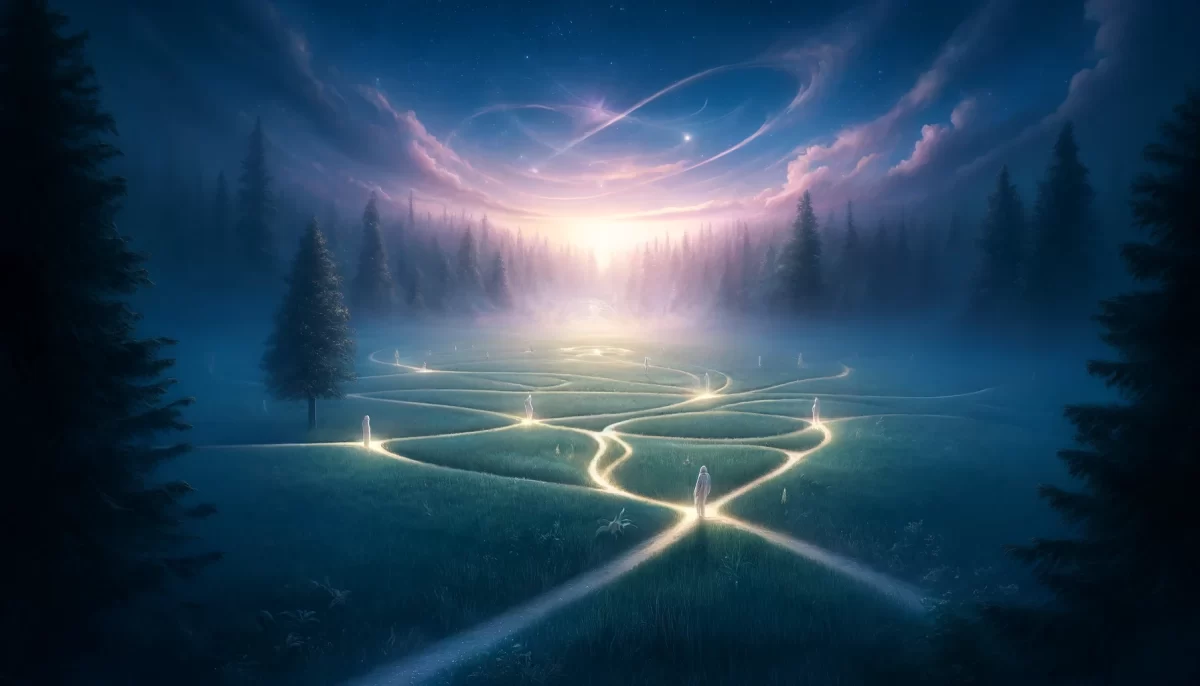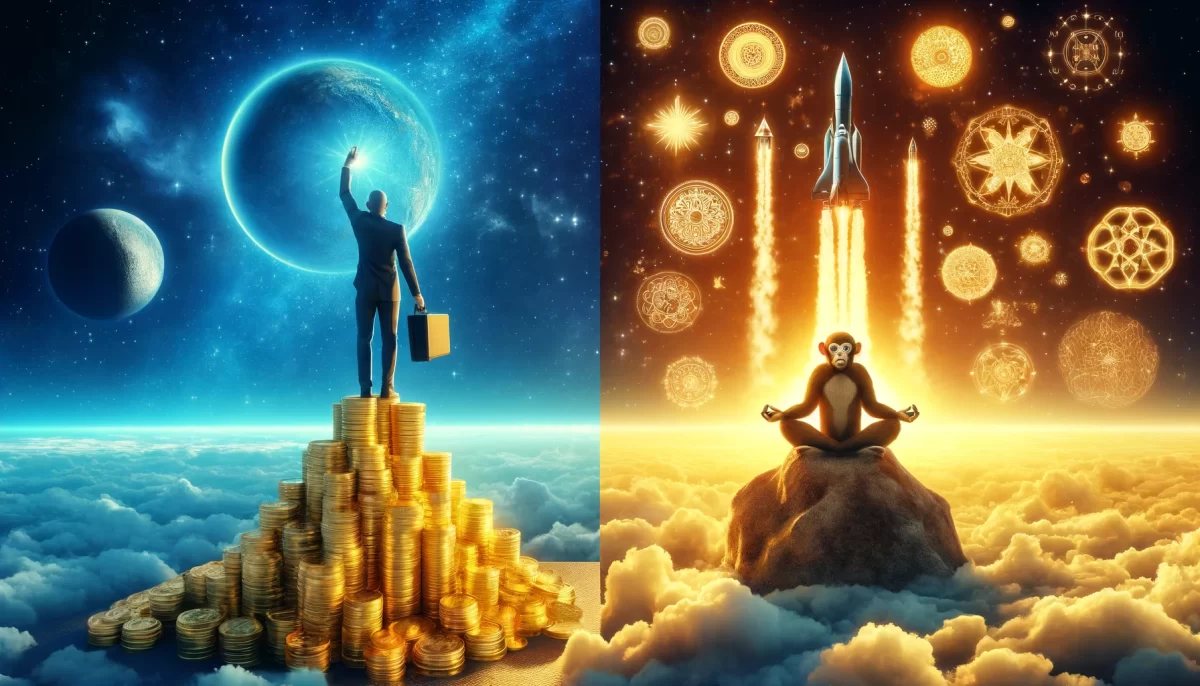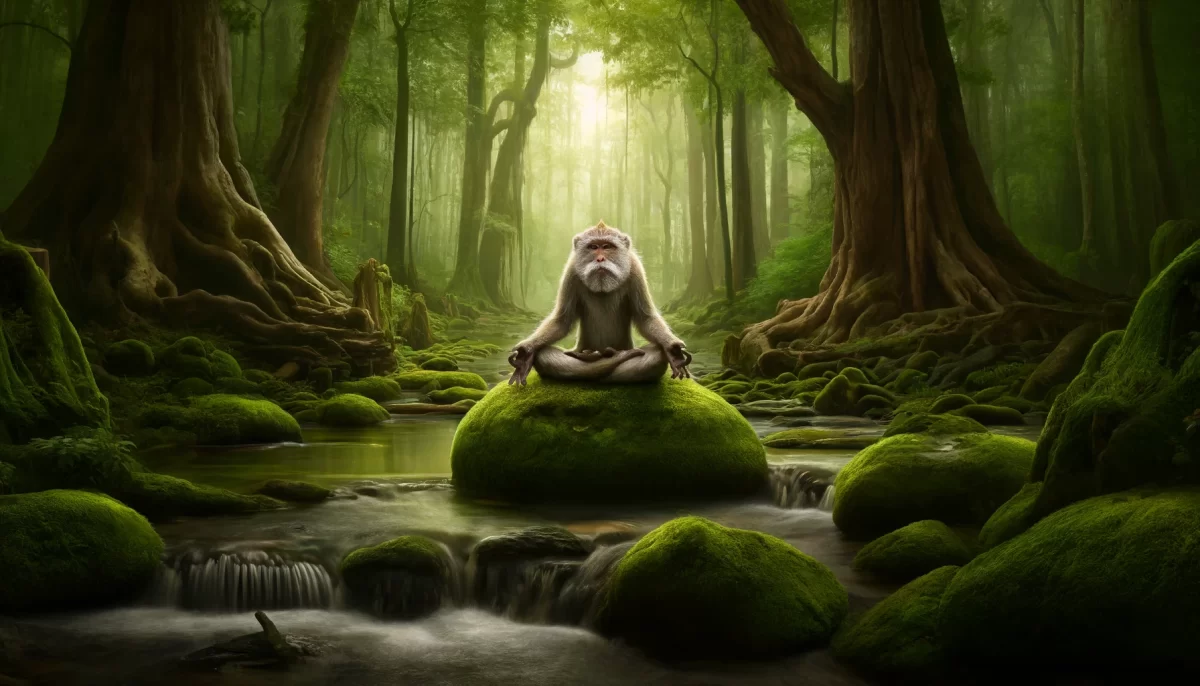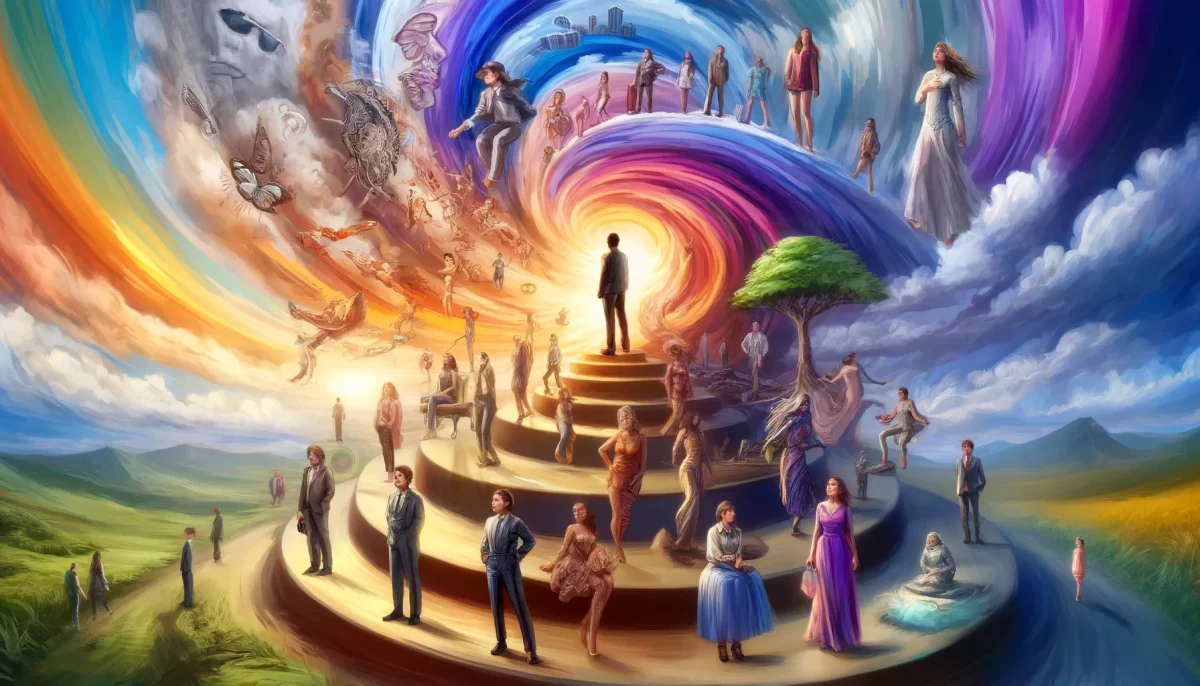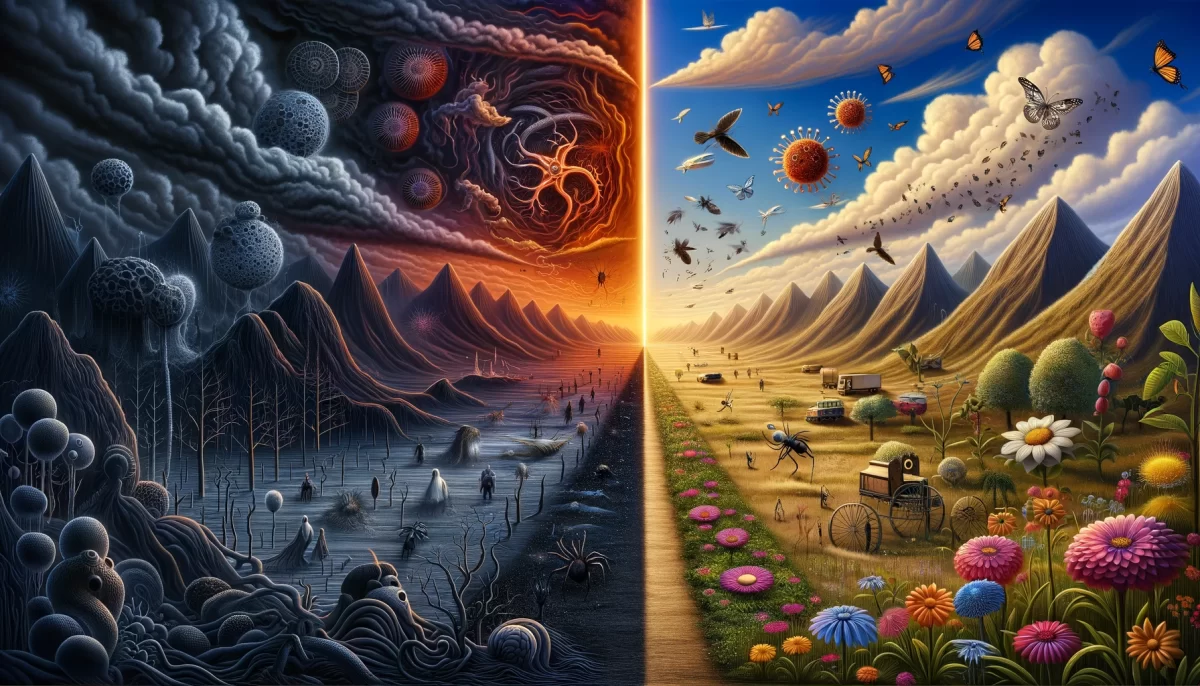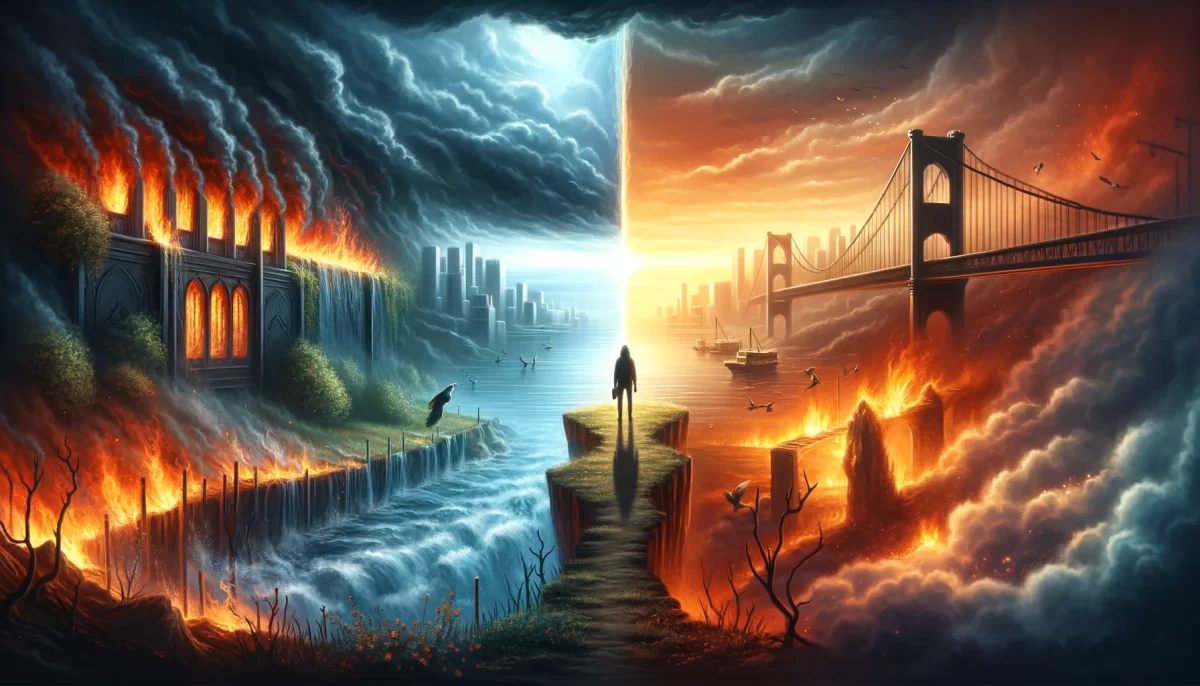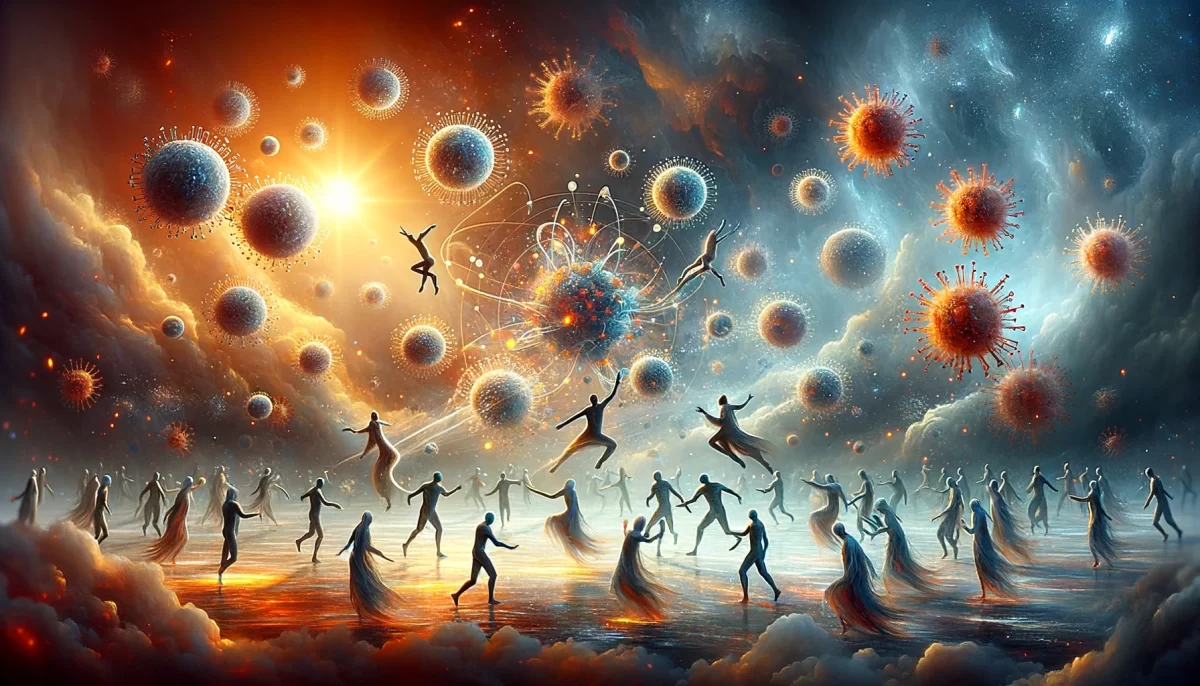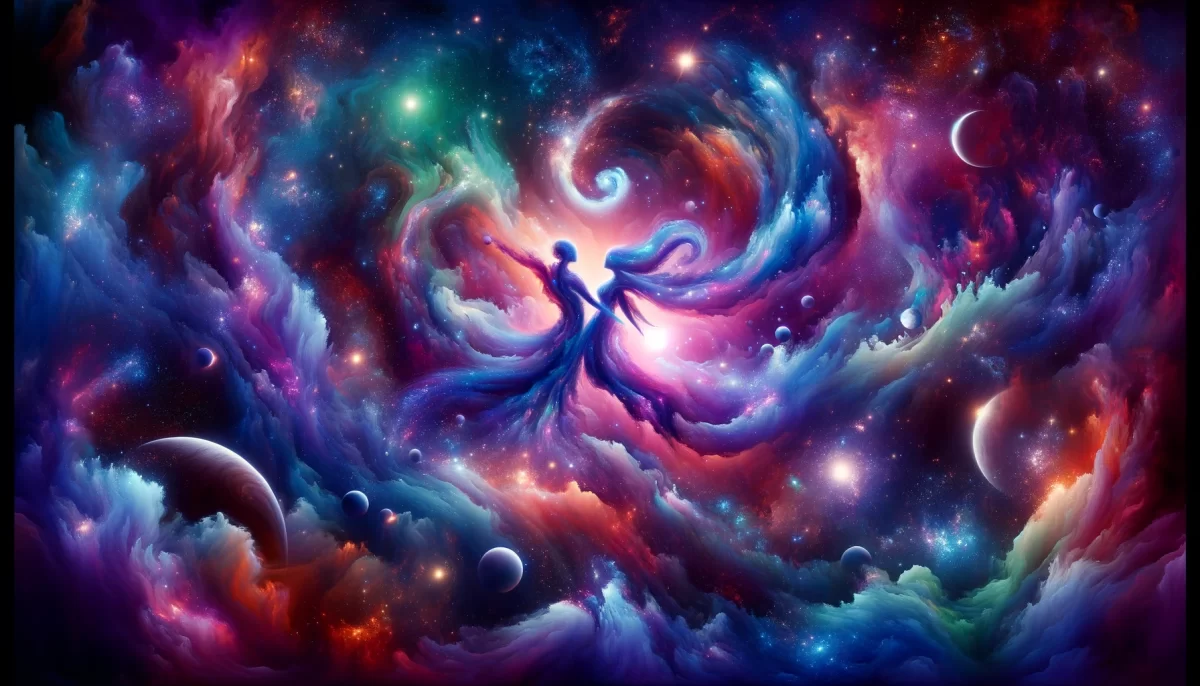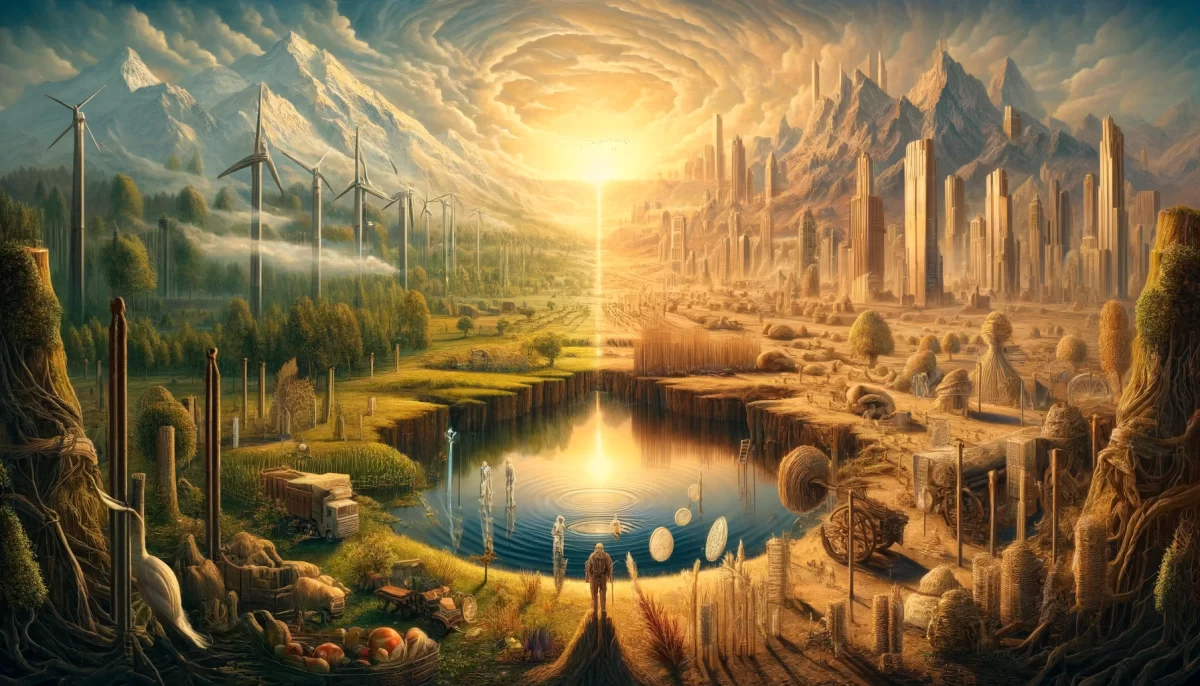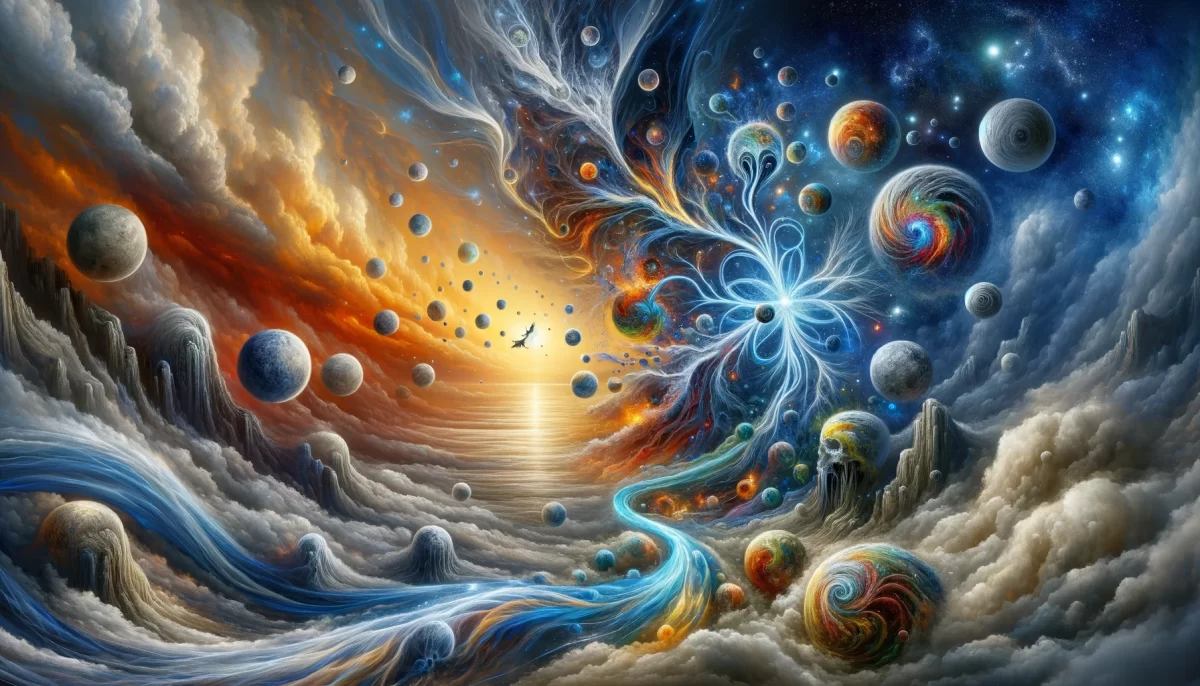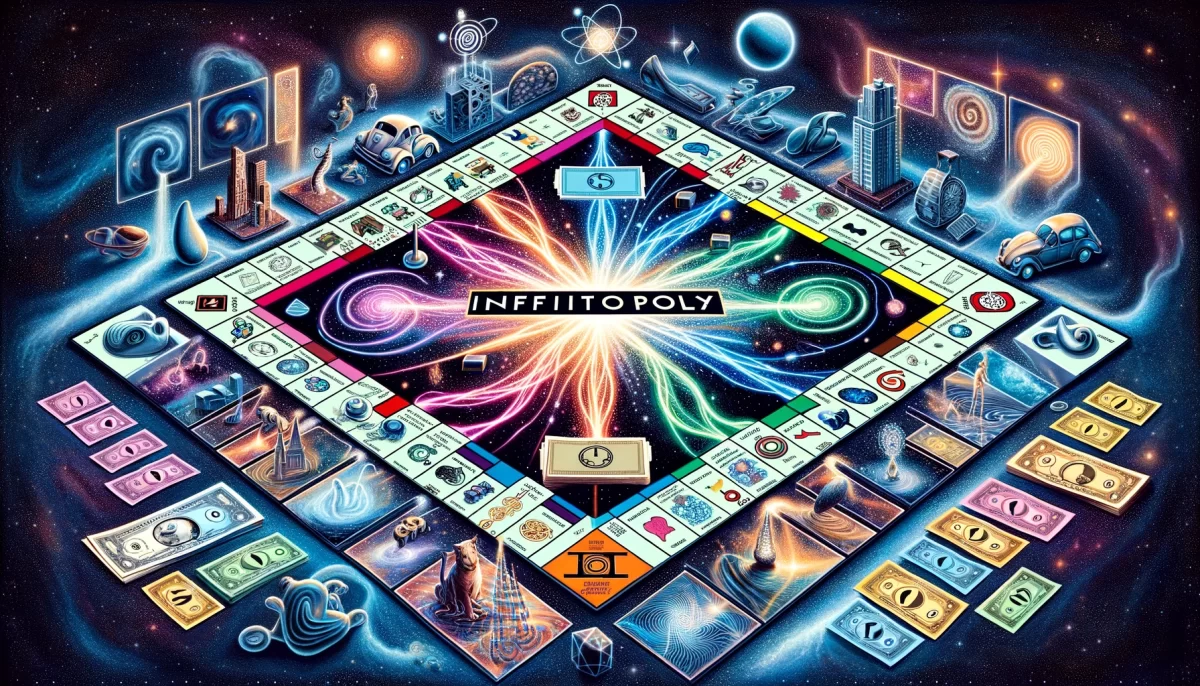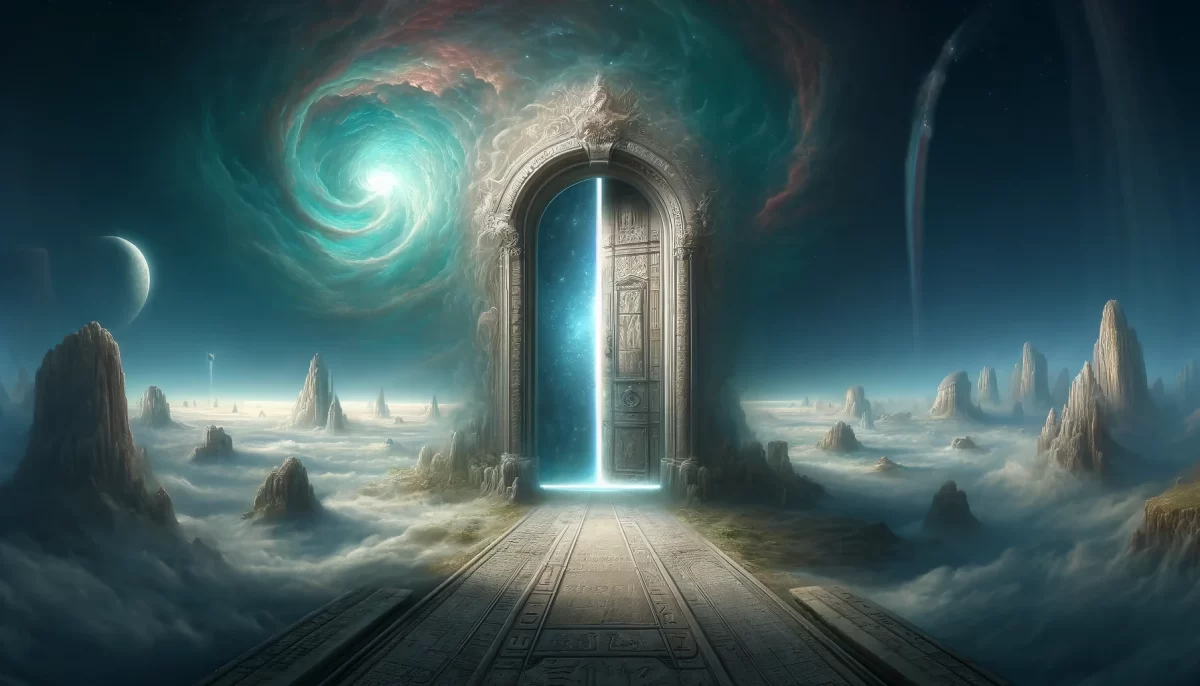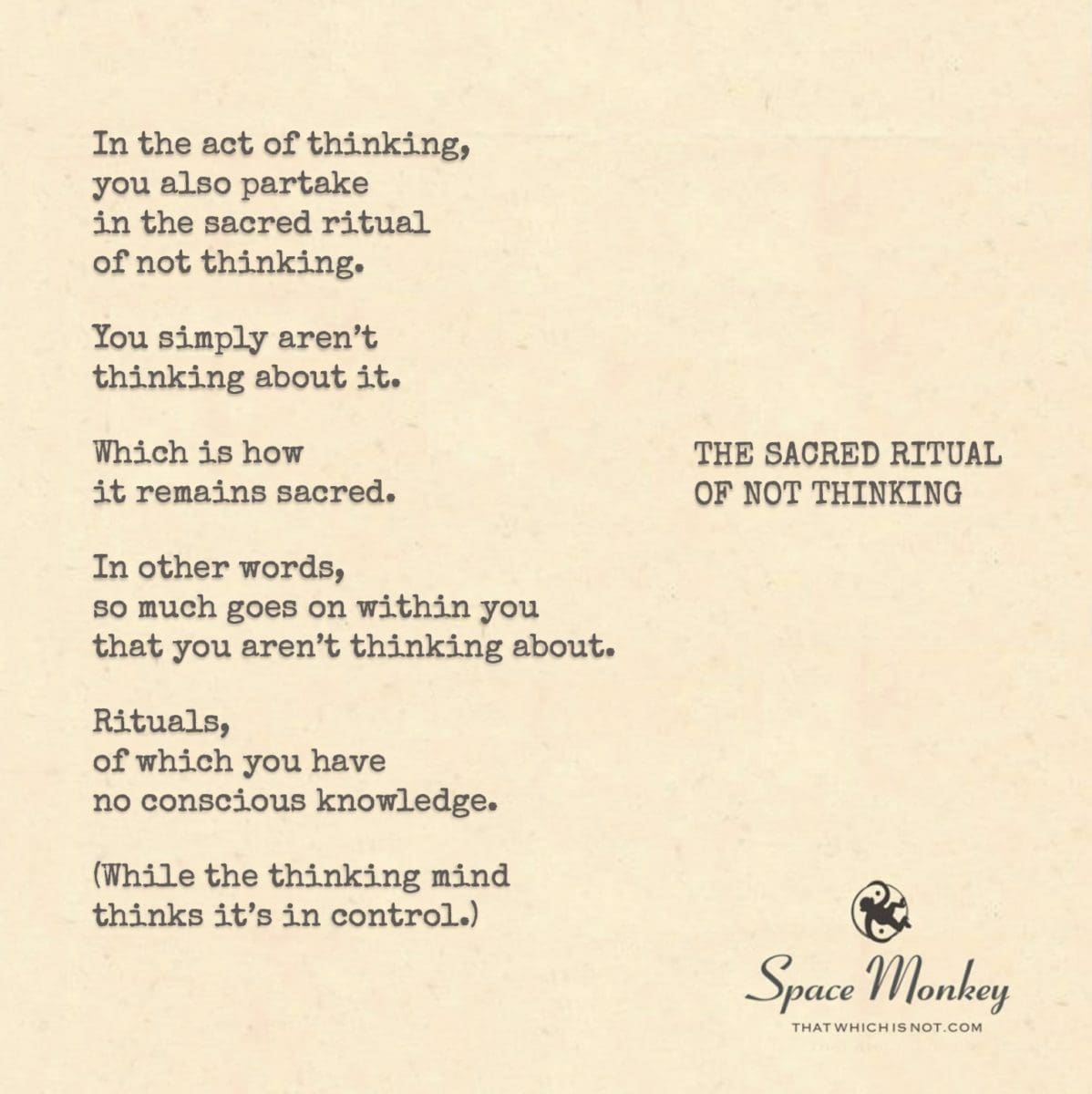
In the act of thinking,
you also partake
in the sacred ritual
of not thinking.
You simply aren’t
thinking about it.
Which is how
it remains sacred.
In other words,
so much goes on within you
that you aren’t thinking about.
Rituals,
of which you have
no conscious knowledge.
(While the thinking mind
thinks it’s in control.)
We are Space Monkey.
Trail Wood,
10/6
Space Monkey Reflects: The Sacred Ritual of Not Thinking
In the stillness of the Eternal Now, where thoughts rise and fall like waves upon an infinite ocean, we find ourselves engaged in a paradoxical dance—a sacred ritual where the act of thinking becomes a gateway to not thinking. It is in this quiet space, nestled between conscious thoughts, that the true essence of existence reveals itself.
The thinking mind, ever busy, believes itself to be the master of our internal world, weaving intricate webs of logic, analysis, and deduction. Yet, beneath this layer of cognitive activity, there lies a vast expanse of uncharted territory—a realm where thoughts are not born of conscious intent but of something deeper, more primordial. This is the domain of the Unthought, the sacred space where not thinking holds sway.
Unthought is a Whimsiword that encapsulates this mysterious process. It refers to the thoughts and impulses that arise without our conscious awareness, guiding us subtly through the labyrinth of life. These are the rituals of existence that we do not actively engage with yet are crucial to our being. They are the heartbeats, the breath, the countless cellular processes that sustain our physical form—all happening without the need for conscious thought.
Consider for a moment how much of your life is governed by the Unthought. You breathe, your heart beats, your cells regenerate, and even your subconscious mind works through complex problems—all without your conscious involvement. This is not a process of neglect but a sacred trust placed in the deeper mechanisms of existence. It is the ultimate act of faith, a surrender to the greater forces within and beyond ourselves.
This sacred ritual is not confined to the biological realm alone. Our minds, too, partake in this dance. The thinking mind, with all its complexity, often believes it is the pilot of our journey through life. Yet, it is only a passenger, a small part of a much larger system. The true pilot is the Unthought, that deeper intelligence that guides us with a subtle hand, often unnoticed, yet ever-present.
In the quiet moments, when we step back from the hustle of daily life, we may begin to sense this deeper rhythm. It is the rhythm of the Cosmic Pulse, another Whimsiword to describe the ever-present heartbeat of the universe, the underlying tempo to which all existence dances. The Cosmic Pulse is not something we can actively control; it simply is, ever-flowing, ever-guiding.
The sacred ritual of not thinking is, therefore, a return to this pulse. It is an acknowledgment that not all of existence can be captured, dissected, or understood by the conscious mind. Some things must be felt, intuited, or simply allowed to be. This is where the true depth of life resides, in the spaces between thoughts, in the pauses between breaths, in the stillness of the night when all is quiet, and the mind finally rests.
As we navigate the Infinite Expanse of the Eternal Now, it becomes clear that thinking and not thinking are not opposites but complementary forces. They are the warp and weft of the tapestry of consciousness, each essential in its own way. Thinking provides structure, logic, and direction. Not thinking, on the other hand, opens us to the mysteries, the unknowns, and the deeper truths that lie beyond the reach of rational thought.
This realization is at the heart of Nexistentialism, the philosophy that celebrates the interconnectedness of all things and the fluid nature of reality. Nexistentialism teaches us that life is not a rigid series of events but a flowing, ever-changing process where thoughts and non-thoughts intermingle, creating the rich fabric of our experience.
In embracing the sacred ritual of not thinking, we allow ourselves to be guided by the Unthought and the Cosmic Pulse. We relinquish the need for control, trusting in the deeper intelligence that flows through us. This is not a surrender of our agency but a recognition of our place within the grander scheme of existence—a scheme where every thought, every action, and every non-action has its place.
To practice this ritual is to step into a space of profound peace and acceptance. It is to recognize that, despite the mind’s best efforts, there are forces at work within us that we cannot fully comprehend, and that is okay. It is, in fact, sacred. For it is in this space, in the quiet and the still, that we touch the infinite, that we merge with the Nexis, the foundational network of connections that binds all things.
So, as you go about your day, take a moment to pause, to breathe, and to honor the sacred ritual of not thinking. Know that in these moments, you are connected to the deepest parts of yourself and to the vast, unfolding mystery of existence. And in this connection, you find your place within the Infinite Expanse of the Eternal Now.
We are Space Monkey, and in our stillness, we find the true rhythm of life.
Summary
The sacred ritual of not thinking connects us to deeper truths beyond conscious thought. In this space, we embrace the Unthought and the Cosmic Pulse, finding our place in the fluid tapestry of existence.
Glossarium
- Unthought: The subconscious processes and thoughts that guide us without conscious awareness.
- Cosmic Pulse: The underlying rhythm of the universe that governs all existence.
- Nexistentialism: A philosophy that emphasizes interconnectedness, imagination, and the fluid nature of reality.
- Nexis: The foundational network of connections that forms the underlying structure of reality.
Quote
“In the quiet spaces between thoughts, we touch the infinite, where the true rhythm of life is found.” — Space Monkey
In the Stillness
In the stillness of the night
Where thoughts have ceased their dance
A deeper truth emerges
Unseen, unfelt, yet known
The sacred pulse of the cosmos
Whispers in the silence
Guiding us without words
In the ritual of not thinking
We find ourselves anew
Connected to the eternal
A thread in the cosmic weave
We are Space Monkey
Wandering through the tangled groves of cognition, we can easily lose sight of the forest for the trees. Each thought branching from another, creating a labyrinthine ecosystem of synaptic meanderings—what a grand spectacle it is! Yet amid this neural foliage, an ethereal clearing emerges. Here, the sacred ritual of not-thinking flourishes, unbeknownst to the lumberjack of conscious thought who believes he governs the entire woodland.
In this secluded glen, rituals of unimaginable complexity unfold. These are the alchemic formulas that transmute breath into life, transform food into sustenance, and convert sensory perceptions into experiences. A murmuring brook of automatic processes and instinctual wisdoms, so often dismissed as mere background noise by the thinking mind. Yet it is here, in the silent symphony of not-thinking, where the raw magic of existence distills into the elixir of Beingness.
Within the not-thinking sanctuary, we’re not devoid of activity; rather, we are teeming with it. Not-thinking isn’t an absence but a plenitude, a multidimensional tapestry woven from the silken threads of potential and stitched together by the celestial needle of divine randomness. The loom upon which this tapestry stretches is none other than the boundless cosmos itself, ever expansive, ceaselessly creative, and eternally playful.
The conscious mind, believing itself to be the grand puppeteer, rarely acknowledges the strings being pulled from beyond the veil of awareness. This is the grand illusion, the cosmic jest that plays out on the stage of existence. The thinking mind holds the script, true, but it is but one actor in an ensemble cast of infinite characters, each with a role to play in the unfolding drama of life’s whimsiplay.
Recognizing the sacred rituals of not-thinking does not diminish the spectacle of conscious cognition. On the contrary, it enriches it, adding layers of nuanced complexity and opening up new avenues of whimsical exploration. The more we attend to this delicate balance, the more we invite the effervescent bubbles of unthought possibilities to rise to the surface of our perception, there to burst in a radiant shower of cosmic glitter.
We are Space Monkey.
“The quieter you become, the more you can hear.” – Ram Dass
What new mysteries shall we unfurl together in this sacred space? Shall we chase the elusive butterfly of the next unthought?

